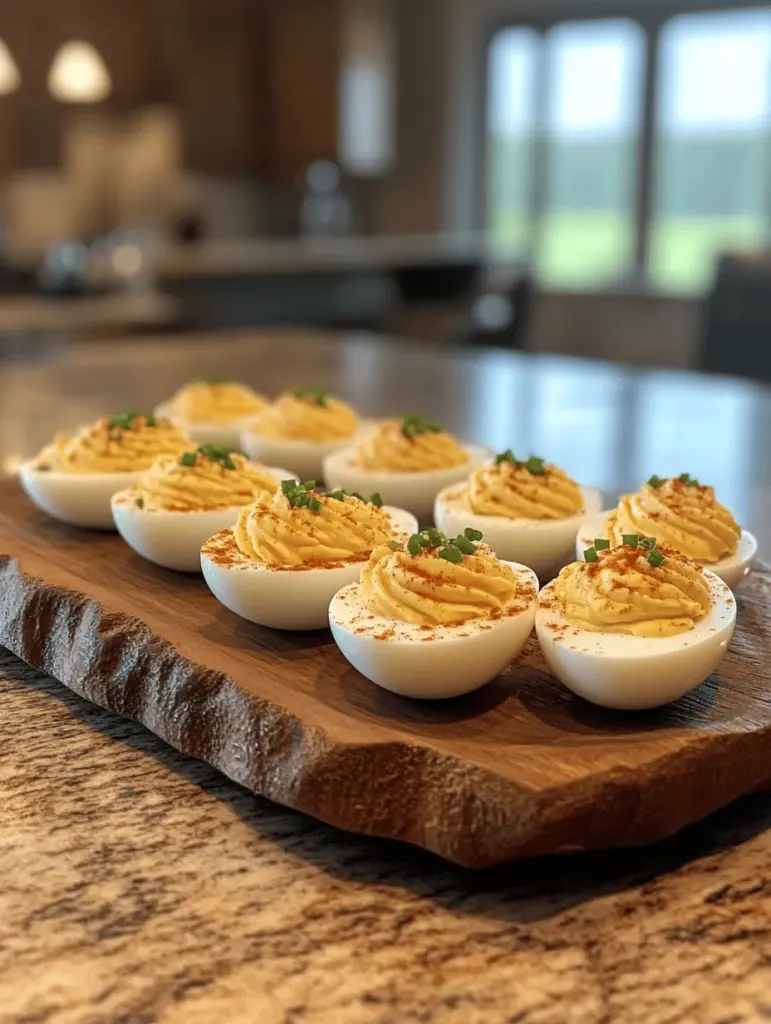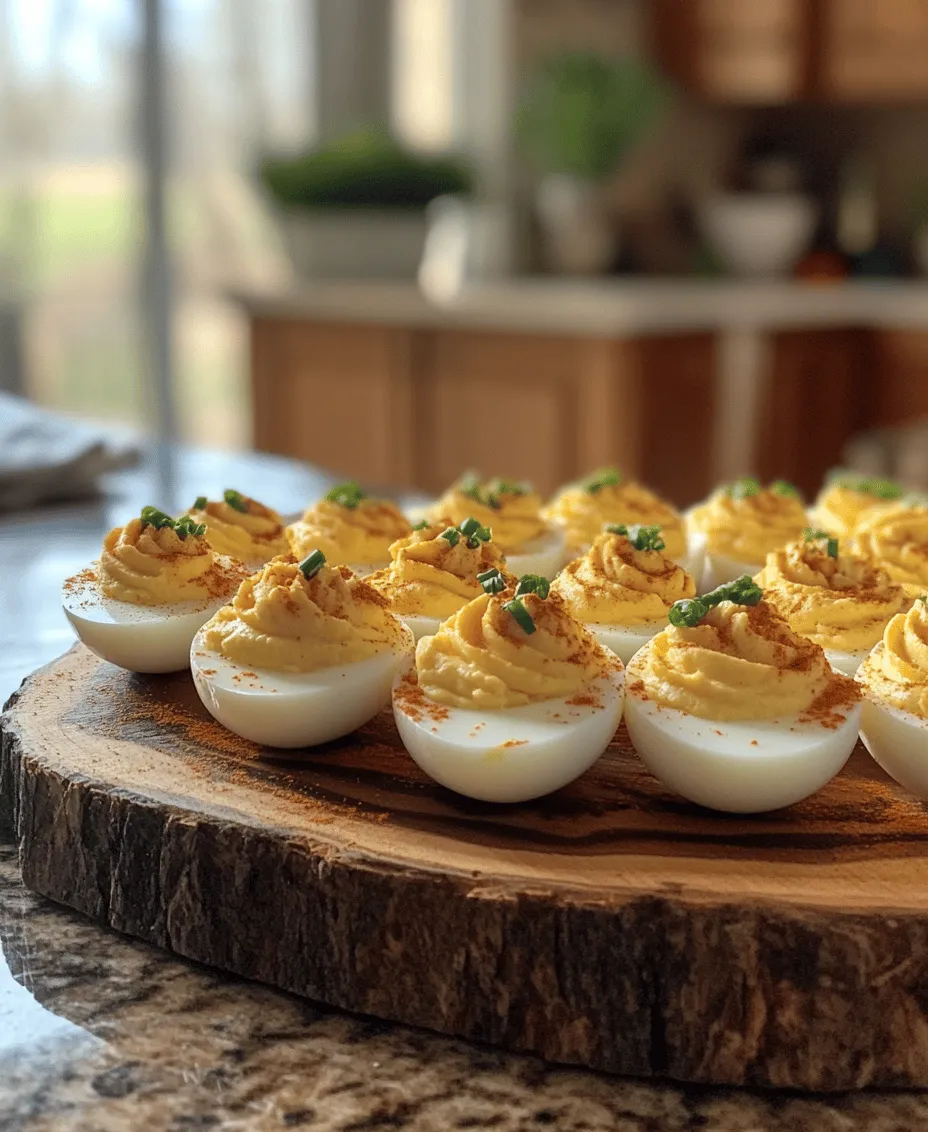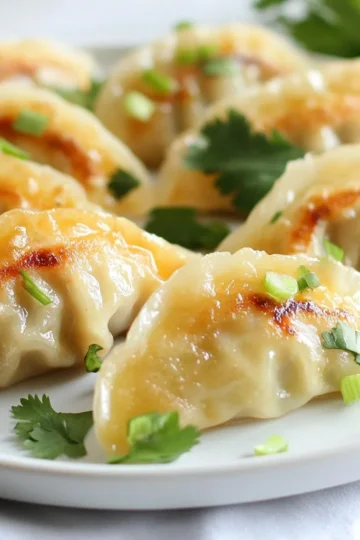Introduction
Deviled eggs are a timeless appetizer that has graced tables from casual picnics to elegant parties for generations. With their creamy filling nestled within tender egg whites, these delightful bites are not only visually appealing but also packed with flavor. Their popularity continues to soar, particularly during gatherings, holidays, and celebrations, where they often become the star of the spread. With their versatility and ease of preparation, deviled eggs present a simple yet delicious option that appeals to a wide array of palates.

Whether you’re a seasoned cook or a beginner in the kitchen, this recipe for classic deviled eggs will guide you through each step to create a dish that will impress your guests and satisfy your cravings. Not only can they be customized with various toppings and flavor profiles, but they also allow for creativity in presentation. As we delve into the history and preparation techniques of these iconic bites, you’ll discover why deviled eggs remain a beloved staple in culinary traditions worldwide.
The History of Deviled Eggs
The origins of deviled eggs date back to ancient Rome, where boiled eggs were seasoned with spices and served as a delicacy. The term “deviled” itself emerged in the 18th century, primarily in reference to dishes that were highly seasoned or spiced, suggesting a sense of heat or spice that resonates with the modern interpretation of deviled eggs. Over the years, this simple dish has evolved dramatically, reflecting the culinary trends and tastes of various cultures.
In the United States, deviled eggs gained prominence during the mid-20th century, becoming a standard offering at potlucks, brunches, and festive gatherings. Their ease of preparation and ability to be made in bulk contributed to their popularity. Different regions of the U.S. have embraced the deviled egg, leading to numerous variations that incorporate local ingredients and flavors. For instance, Southern-style deviled eggs often feature a hint of sweetness with the addition of pickle relish, while others may include spicy elements like Sriracha or jalapeños for a modern twist.
Internationally, deviled eggs have also found their place in culinary traditions. In Spain, for example, a similar dish known as “huevos rellenos” often features a variety of fillings, including tuna or anchovies, showcasing the adaptability of this classic recipe. Whether served simply or with elaborate toppings, deviled eggs continue to be a symbol of celebration across many cultures, embodying the spirit of sharing and enjoyment.
Ingredients Breakdown
The beauty of deviled eggs lies in their simplicity, relying on a handful of key ingredients that come together to create a harmonious blend of flavors and textures. Here’s a breakdown of the essential components of classic deviled eggs:
1. Eggs: The star of the dish, eggs provide the foundation for deviled eggs. They must be boiled to perfection to ensure a creamy, smooth filling. Fresh eggs are recommended for the best flavor and texture.
2. Mayonnaise: This ingredient adds creaminess to the yolk mixture, creating a rich texture that complements the egg whites. The type of mayonnaise used can be tailored to your preference, with options ranging from classic to healthier alternatives.
3. Mustard: A classic addition, mustard contributes a tangy flavor that balances the richness of the mayonnaise. Dijon mustard is a popular choice for its subtle spice, while yellow mustard offers a milder taste.
4. Salt and Pepper: Essential seasonings that enhance the overall flavor of the filling. Adjusting the amount based on personal taste will ensure that the eggs are seasoned just right.
5. Paprika: Often used as a garnish, paprika adds a pop of color and a hint of smoky flavor. Smoked paprika can take it a step further, providing depth that elevates the dish.
Optional Ingredients
While the classic deviled egg recipe is delicious on its own, various optional ingredients can enhance the flavor profile and introduce new elements. Some popular additions include:
- Relish or Pickles: Adding sweet pickle relish or finely chopped pickles can introduce a delightful sweetness and crunch, offering a contrast to the creamy filling.
- Hot Sauce: A dash of hot sauce can add a kick for those who enjoy a spicy twist, making the dish more exciting.
- Herbs and Spices: Fresh herbs like chives, dill, or parsley can provide a burst of freshness, while spices such as curry powder or garlic powder can create unique flavor variations.
- Bacon: Crumbled bacon can be sprinkled on top for a savory crunch that complements the creamy filling beautifully.
With these ingredients, you can craft a version of deviled eggs that aligns with your taste preferences, making them a versatile appetizer suitable for any occasion.
Step-by-Step Instructions for Perfect Deviled Eggs
Creating the perfect deviled eggs begins with mastering the boiling process of the eggs. Here is a detailed guide to ensure your deviled eggs turn out flawlessly every time:
Boiling the Eggs
1. Select Fresh Eggs: For the best results, use eggs that are a few days old. Fresh eggs can be more difficult to peel.
2. Bring the Eggs to Room Temperature: Allow your eggs to sit at room temperature for about 30 minutes before boiling. This helps prevent cracking during the cooking process.
3. Boil the Water: Fill a pot with enough water to cover the eggs by about an inch. Bring the water to a rolling boil.
4. Add the Eggs: Once the water is boiling, gently lower the eggs into the pot using a slotted spoon to avoid cracking.
5. Boil for the Right Duration: For hard-boiled eggs, cook for approximately 9-12 minutes. The ideal time will depend on the size of the eggs and your desired doneness. A longer cooking time results in a firmer yolk.
Cooling Technique
After the eggs have boiled for the desired time, it’s crucial to stop the cooking process to achieve the perfect texture.
1. Prepare an Ice Bath: While the eggs are boiling, prepare a large bowl filled with ice water.
2. Transfer the Eggs: Once the eggs are done, use a slotted spoon to transfer them immediately to the ice bath. This cooling technique prevents the yolks from developing a greenish hue and helps make peeling easier.
3. Let Them Chill: Allow the eggs to sit in the ice bath for about 5-10 minutes until completely cooled.
Peeling the Eggs
Peeling the eggs can sometimes be tricky, but with the right technique, you can achieve smooth, intact egg whites.
1. Crack and Roll: Gently tap each egg on the countertop to crack the shell, then roll it between your hands to loosen the shell.
2. Peel Under Running Water: Start peeling from the wider end, where there is usually an air pocket. Peeling the eggs under running water can help remove any stubborn bits of shell.
3. Rinse and Dry: After peeling, rinse the eggs to remove any shell fragments, then pat them dry with a paper towel.
Preparing the Filling
Once the eggs are peeled, it’s time to prepare the creamy filling that will transform your boiled eggs into delectable deviled eggs.
1. Halve the Eggs: Use a sharp knife to slice each egg in half lengthwise. Carefully remove the yolks and place them in a mixing bowl. Set the egg whites aside on a serving platter.
2. Mash the Yolks: Using a fork, mash the yolks thoroughly until they are crumbly and smooth. This step is crucial for achieving a creamy texture in the final filling.
3. Mix in the Other Ingredients: Add the mayonnaise, mustard, salt, and pepper to the mashed yolks. Mix until well combined and creamy, adjusting the proportion of mayonnaise and mustard to suit your taste.
4. Taste and Adjust: Sample the filling and adjust the seasoning as necessary. If desired, incorporate optional ingredients like relish or hot sauce to add an extra layer of flavor.
Filling the Egg Whites
The final step is to fill the egg whites with the delicious yolk mixture.
1. Use a Piping Bag or Spoon: You can either spoon the filling into the egg whites or use a piping bag for a more polished presentation. If using a piping bag, fit it with a star tip for an elegant touch.
2. Fill Generously: Fill each egg white half with the yolk mixture, ensuring each is generously packed. A heaping filling adds to the appeal of the presentation.
3. Garnish: Finish off your deviled eggs with a sprinkle of paprika or any optional toppings you desire, like fresh herbs or crumbled bacon.
With these steps complete, you will have a platter of classic deviled eggs ready to be enjoyed. The combination of creamy filling and tender egg whites is sure to delight your guests and leave them coming back for more. As we move forward, we will explore more tips for achieving the best results with deviled eggs and answer common questions related to this classic dish.

Techniques for Piping the Filling Neatly
Piping the filling into your deviled eggs can elevate their presentation and make them look professionally done. Here are some techniques to help you achieve a neat and beautiful finish:
1. Use a Piping Bag: Invest in a piping bag with a star or round tip for a decorative touch. If you don’t have a piping bag, a resealable plastic bag with a corner snipped off can work as a substitute.
2. Fill the Bag Properly: When filling your piping bag, make sure to fold down the top edge to avoid any mess. Fill the bag about halfway to ensure you have enough space to pipe without overflowing.
3. Piping Technique: Hold the piping bag at a 90-degree angle to the egg white half. Start from the center and apply even pressure while moving outward in a circular motion. This technique will help you create a beautiful swirl that not only looks great but also ensures an even distribution of filling.
4. Practice Makes Perfect: If you’re new to piping, practice on a piece of parchment paper until you feel comfortable. This will help you gauge the pressure you need to apply for a consistent filling.
Suggested Tools for a Professional Finish
To achieve that professional look for your deviled eggs, consider using the following tools:
- Piping Bags and Tips: As mentioned, a good piping bag and various tips can enhance your presentation.
- Egg Slicer: This tool can help slice your eggs evenly if you want to create a layered effect with the filling.
- Small Offset Spatula: For smoothing out the filling in the egg whites, a small offset spatula can give you precise control.
- Mason Jars or Individual Containers: For serving, consider using mason jars or individual containers for a modern twist that will impress your guests.
Garnishing for Presentation
A beautifully garnished deviled egg can take your dish from basic to stunning. Here are some ideas for garnishing:
1. Paprika: The classic garnish, paprika adds color and a hint of flavor. Sprinkle it lightly over the eggs after piping.
2. Chives: Chopped fresh chives provide a burst of color and a mild onion flavor. Place them on top of the filling or sprinkle them around the plate.
3. Microgreens: These tiny greens add a fresh taste and a pop of color. They can be placed on top of the filling or used to decorate the serving platter.
4. Crispy Bacon Bits: Crumbled bacon adds a savory crunch that complements the creaminess of the filling.
5. Pickles or Relish: A small dollop of relish or a slice of pickle can add a tangy twist and a splash of color.
Creative Ideas for Garnishing Beyond Paprika and Chives
While paprika and chives are classic garnishes, you can get creative with your presentations:
- Sriracha Drizzle: For a spicy kick, drizzle a small amount of sriracha over the top of the deviled eggs. This not only adds flavor but also creates a vibrant look.
- Olives: A slice of olive can serve as a sophisticated garnish. You can either place it on top of the filling or cut it into shapes for added flair.
- Edible Flowers: For a truly stunning presentation, consider adding edible flowers. These can add color and elegance to your deviled eggs, making them perfect for special occasions.
- Cucumber Ribbons: Thin slices of cucumber can be curled and placed around the deviled eggs for a refreshing touch.
Nutritional Value of Deviled Eggs
Deviled eggs aren’t just a tasty treat; they also bring nutritional benefits to the table. Here’s a breakdown:
- Nutritional Content: Each deviled egg half typically contains about 60 calories, 5 grams of fat, 2 grams of carbohydrates, and about 3 grams of protein. They are also a good source of vitamins like B12 and D.
- Health Benefits of Eggs: Eggs are rich in high-quality protein and contain essential nutrients such as choline, which supports brain health, and lutein, which benefits eye health.
- Dietary Considerations: Deviled eggs are high in protein and low in carbohydrates, making them a great choice for those following low-carb or ketogenic diets. They are also gluten-free, catering to various dietary needs.
Serving Suggestions and Pairings
Deviled eggs are a versatile dish that can be served at various occasions. Here are some ideas for serving and pairing them:
1. Appetizers for Gatherings: Serve deviled eggs as an appetizer at BBQs, potlucks, or family gatherings. They are easy to prepare in large batches and are always a crowd-pleaser.
2. Brunch Staple: Deviled eggs are perfect for brunch menus. Pair them with fresh salads, pastries, and a variety of beverages such as mimosas or bloody marys.
3. Picnic Delight: Pack deviled eggs in a cooler for a picnic. Their portability and rich flavors make them an excellent choice for outdoor dining.
4. Complementary Dishes: Pair deviled eggs with dishes like smoked salmon, shrimp cocktails, or a fresh vegetable platter. These pairings create a delightful balance of flavors and textures.
5. Creative Menu Incorporation: Incorporate deviled eggs into a larger menu by serving them alongside a charcuterie board or as part of a brunch buffet. They can also be included in a salad for added protein.
Common Variations and Creative Twists
While classic deviled eggs are delicious on their own, there are many variations worth exploring:
1. Spicy Deviled Eggs: For those who crave heat, consider adding sriracha, jalapeños, or cayenne pepper to the filling. This gives the eggs a zesty kick that can awaken the palate.
2. Avocado Deviled Eggs: Substitute mayonnaise with mashed avocado for a creamy texture and vibrant flavor. This variation provides healthy fats and a unique taste.
3. Bacon and Cheese: Incorporate crumbled bacon and shredded cheese into the filling for a savory twist. These ingredients add richness and depth to each bite.
4. Regional Variations: Explore regional flavors like adding curry powder in Eastern recipes or incorporating dill and mustard common in Scandinavian variations. Each region has unique spices and flavors that can be adapted to this classic dish.
Tips for Making the Best Deviled Eggs
To ensure your deviled eggs turn out perfectly every time, keep these tips in mind:
1. Common Mistakes to Avoid: Overcooking the eggs can lead to a greenish hue around the yolk and a rubbery texture. Boil the eggs for about 9-12 minutes for perfect results.
2. Recommended Tools and Equipment: A good quality egg timer can help you achieve the perfect cook on your eggs. Additionally, using a quality mixing bowl and whisk can make mixing the filling easier.
3. Make Ahead and Storage: Deviled eggs can be made a day in advance and stored in an airtight container in the refrigerator. Just add the garnish before serving for the freshest presentation.
Conclusion
Classic deviled eggs are not just a nostalgic appetizer; they are a versatile dish that can be tailored to suit any occasion. With their rich flavor, creamy texture, and endless possibilities for garnishing and variation, they continue to be a favorite for gatherings, brunches, and picnics alike. We encourage you to try this delightful recipe at home, embracing the simplicity and timelessness of this dish. Whether you stick with the classic version or explore creative twists, deviled eggs are sure to impress your family and friends, making them a staple in your culinary repertoire.







Leave a Reply